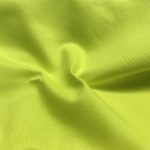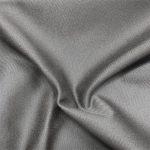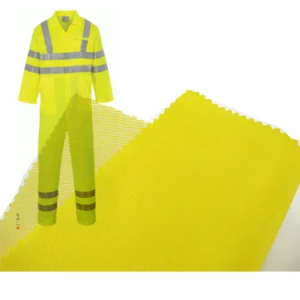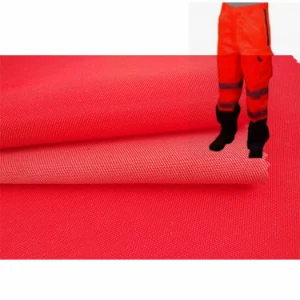What Is Hi-Vis Fabric?
Hi-vis fabric is designed to be highly visible in various lighting conditions, especially in low-light or high-risk environments. The purpose of the fabric is to make the wearer more visible to others, which reduces the risk of accidents and injuries. It does this by using bright, fluorescent colors like neon yellow, orange, and lime green, along with reflective materials that bounce light back to its source.
Types of Hi-Vis Fabric Materials
Hi-vis fabrics are made from a variety of materials, each chosen for their unique properties that enhance visibility and durability:
- Polyester: Polyester is a common choice for hi-vis fabrics because it’s durable and resistant to environmental factors. It also holds bright dyes well, which is great for high-visibility applications.
- Cotton-Polyester Blends: These blends are popular in workwear that needs to be comfortable and highly visible. They combine the comfort of cotton with the strength of polyester.
- Modacrylic: Modacrylic is a flame-resistant synthetic fiber often used in hi-vis fabrics for environments where fire hazards are present.
- Microporous Films and Coatings: These materials are applied to fabrics to enhance properties like breathability and water resistance while maintaining high visibility.
Certificates and Testing Standards
Making sure hi-vis fabrics are safe and high-quality involves testing and meeting international standards. Our hi-vis fabrics meet and exceed several key certifications and standards, including:
- ANSI/ISEA 107: This American standard covers the design, performance, and material requirements for high-visibility safety apparel. It includes requirements for the amount of fluorescent and reflective material, placement of reflective materials, and overall garment design.
- EN ISO 20471: This European standard sets the requirements for high-visibility clothing that visually signals the user’s presence. It includes specifications for color, retro-reflective material, and minimum areas of high-visibility materials.
- AS/NZS 1906.4: This Australasian standard covers the high-visibility materials used in safety garments, including their photometric performance, color, and physical properties.
Testing Procedures
To make sure our hi-vis fabrics meet these standards, they go through a series of tests:
1. Reflectivity Testing:
- Standard: EN ISO 20471 and ANSI/ISEA 107
- Description: We use photometric testing equipment to measure the reflective properties of the fabric to make sure they meet the standards. These tests measure how well the fabric reflects light back to its source, which is important for visibility in low-light conditions.
2. Colorfastness Testing:
- Standard: ISO 105-C06 (Colorfastness to Washing), ISO 105-B02 (Colorfastness to Light)
- Description: This test makes sure the fabric keeps its bright color after being exposed to light, washing, and other environmental conditions. We subject the fabric to simulated washing cycles and prolonged exposure to UV light to see if it fades or changes color.
3. Abrasion and Tear Resistance:
- Standard: ISO 12947-2 (Martindale Abrasion Resistance), ISO 13937-2 (Tear Strength)
- Description: These tests assess the fabric’s durability and ability to withstand harsh working conditions without degrading. The abrasion resistance test involves rubbing the fabric against a standard abrasive surface, while the tear resistance test measures the force required to propagate a tear.
4. Moisture Management:
- Standard: AATCC 195 (Liquid Moisture Management Properties)
- Description: Fabrics are tested for their ability to wick away sweat and moisture, ensuring comfort for the wearer. The test evaluates the fabric’s capacity to transport moisture from the skin to the outer surface, where it can evaporate, thus keeping the wearer dry and comfortable.
Applications of Hi-Vis Fabric
The versatility of hi-vis fabric makes it suitable for a wide range of applications across different industries:
- Construction: Hi-vis workwear is essential on construction sites where visibility can be compromised by machinery, debris, and varying weather conditions. Our fabrics ensure that workers remain visible to equipment operators and site supervisors, significantly reducing the risk of accidents.
- Roadside Assistance and Traffic Management: Workers involved in roadside assistance, traffic management, and road construction are often exposed to moving vehicles. Our hi-vis fabrics are designed to ensure these workers are highly visible to drivers, reducing the likelihood of accidents in these high-risk environments.
- Emergency Services: Firefighters, paramedics, and other emergency responders require high-visibility uniforms to remain visible in chaotic and often poorly lit situations. Our hi-vis fabrics ensure they stand out, facilitating better coordination and quicker response times.
- Warehousing and Logistics: In busy warehouses and logistics centers, our hi-vis fabrics help prevent collisions between workers and moving equipment such as forklifts. Enhanced visibility is critical in these fast-paced environments to maintain a safe workspace.
Conclusion
High-visibility fabric is an indispensable element in the safety arsenal of industrial workwear. By choosing our hi-vis fabrics, you are investing in superior protection, durability, and comfort for your workforce. Our expertise and dedication to quality ensure that every fabric we produce meets the highest standards of safety and performance, providing peace of mind in the most challenging environments.

 100% COTTON FABRIC
100% COTTON FABRIC COTTON STRETCH FABRIC
COTTON STRETCH FABRIC POLYESTER/COTTON FABRIC
POLYESTER/COTTON FABRIC OTHERS FABRIC
OTHERS FABRIC
